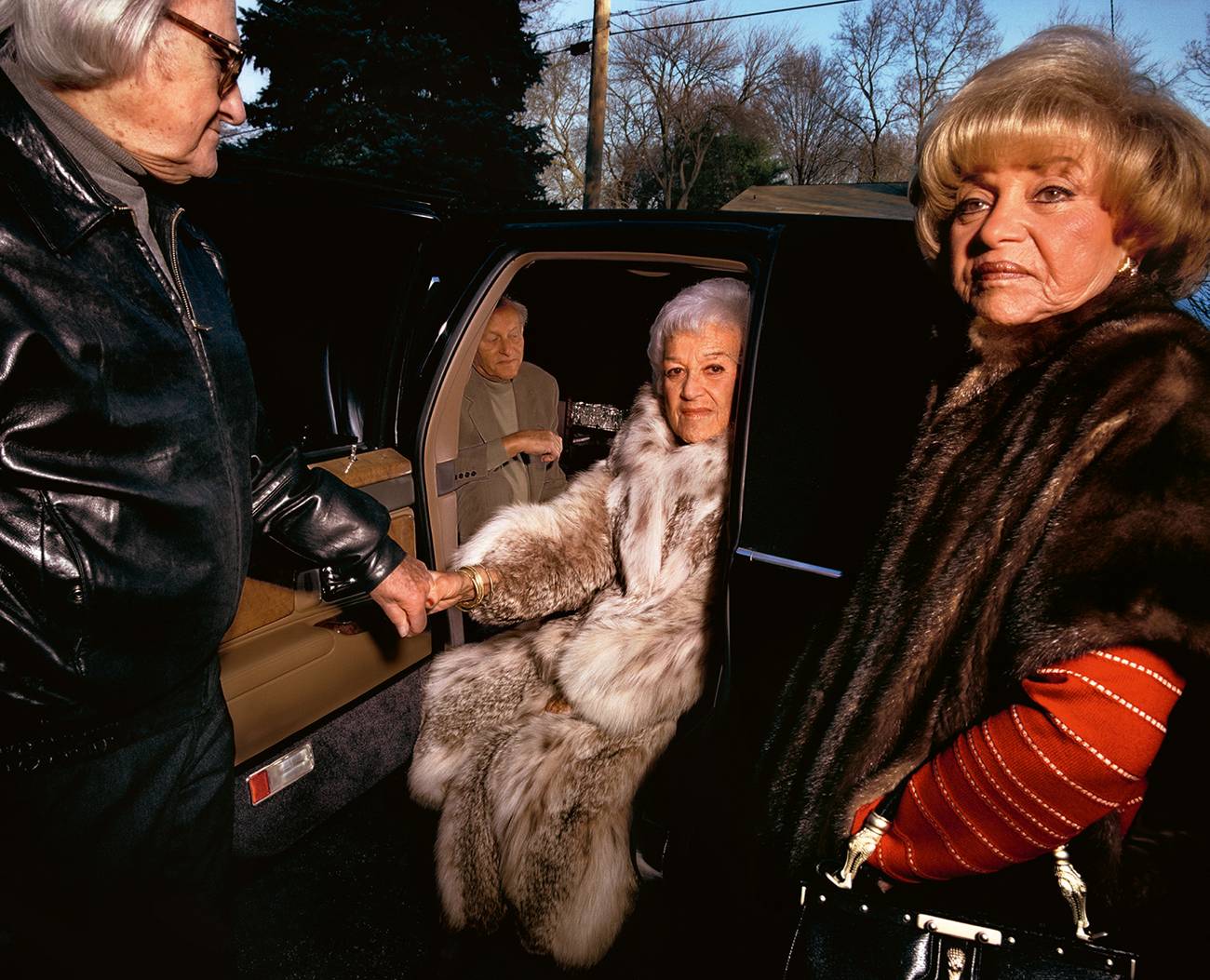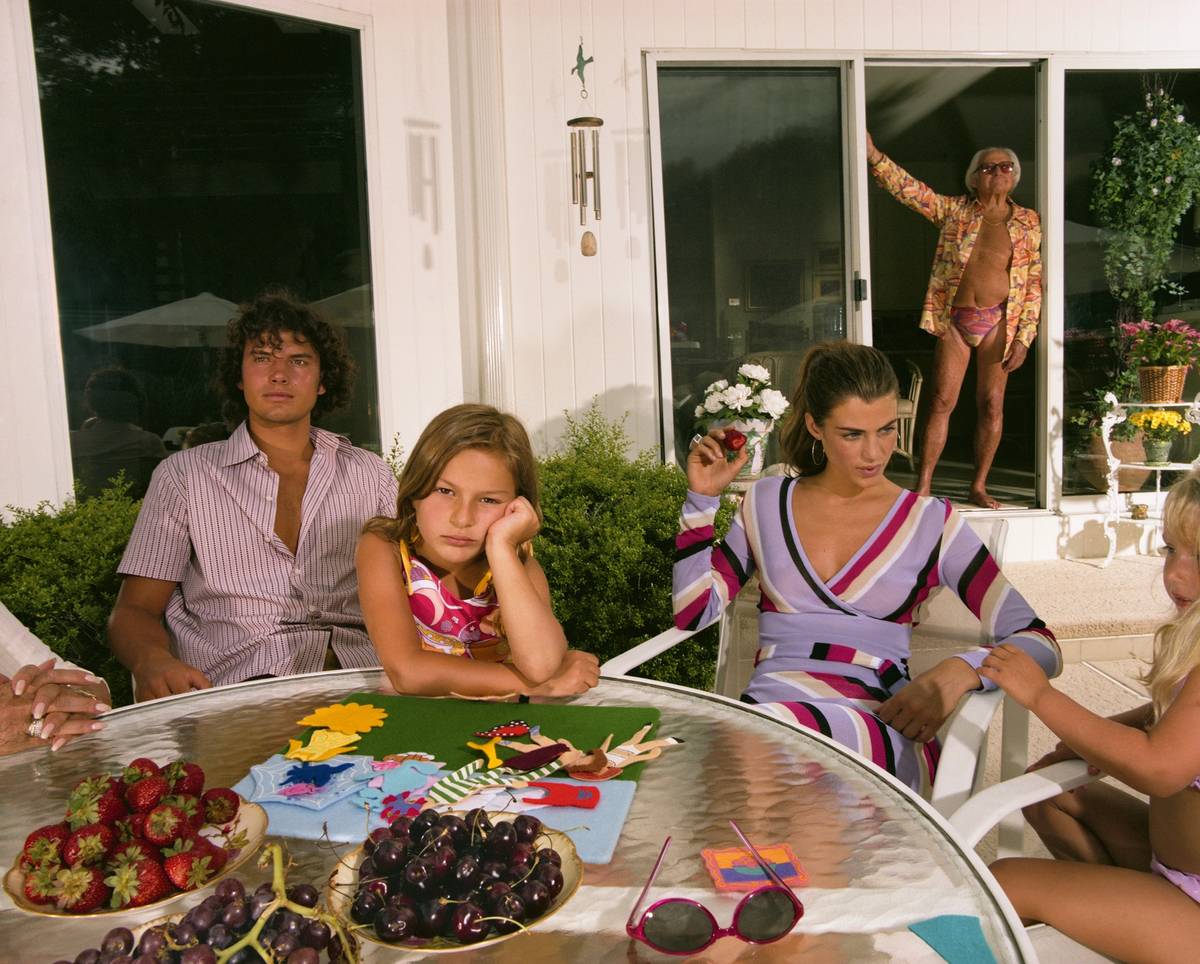 Family Matters
Family Matters
LESLIE CAMHI
 Gillian Laub, ‘Grandpa helping Grandma out,’ 1999, from ‘Family Matters’ (Aperture, 2021)© GILLIAN LAUB
Gillian Laub, ‘Grandpa helping Grandma out,’ 1999, from ‘Family Matters’ (Aperture, 2021)© GILLIAN LAUB
Gillian Laub’s new book of photos takes an incisive look at her colorful, loving Jewish family, their politics, and the hard questions in between.
Just days before the opening of “Family Matters,” Gillian Laub’s solo exhibition at Manhattan’s International Center for Photography—a multimedia presentation including text messages, voice mail recordings and 20 years’ worth of Laub’s photographs of her wealthy, over-the-top, in-your-face, loving, generous, and exceedingly expressive, suburban Jewish family, whose sudden turn Trumpward, in 2016, rocked her world—I went to visit the photographer in the Tribeca loft that serves as both her studio and the home she shares with her husband, an Israeli writer, and their two young daughters.
On a nearby flat file sat a dozen small, laminated photographic cutouts which Laub’s late grandparents brought back from a trip to New Mexico, where they visited a photo studio and dressed up in Southwestern garb; the elderly Jewish couple, incongruous in cowboy boots, jeans, and bolo ties, smooching and otherwise hamming it up for the camera, appeared uncannily animated.
Hanging on a far wall was a more sober portrait: a classic, black-and-white photograph from the 1930s, showing the pioneering photojournalist Margaret Bourke-White (the first woman photographer on the staff of Life magazine) setting up a shot while perched precariously on a gargoyle jutting from the Chrysler Building, 61 floors above the streets of Manhattan.
Gillian Laub: ‘Family Matters’ (Aperture, 2021)AVAILABLE AT APERTURE.ORG/BOOKS/GILLIAN-LAUB-FAMILY-MATTERS/
I think I know why Laub loves this picture. For decades in her own work, she’s navigated the thinnest of margins, threading her way through religious and racially motivated conflicts and painful political divisions. Her first book, Testimony, focused on individual Jewish and Arab civilians in Israel and the West Bank who had suffered the effects, in their bodies, minds, and hearts, of the Second Intifada’s violence—the maimed survivors of suicide bombings, reprisal attacks by settlers, or random landmines. Countering the constant rattle of sensationalist headlines, Laub’s preternaturally calm portraits, accompanied by the words of survivors, delved deep into Israel’s torn and fraying social fabric, finding common threads of humanity.
Her second book, Southern Rites, began as a magazine assignment in 2002, when a student in Mount Vernon, a small town in south-central Georgia, wrote to editors at Spin to protest her high school’s racially segregated proms, which she and her boyfriend, a biracial couple, had been prevented from attending. After completing that first assignment, Laub returned repeatedly to Mount Vernon, slowly gaining the trust of more students, while also getting her car’s tires slashed and being threatened with further violence. When her photo essay, “A Prom Divided,” was published in The New York Times Magazine in May 2009, it provoked national outrage, and afterward local parents voted to integrate the prom.
Yet two years later, tragedy struck: A 22-year-old African American man, the prom date of a student to whom Laub had become close, was shot and killed by a 62-year-old white man. The documentary Laub directed and co-produced for HBO (also called Southern Rites), begins with the story of the proms but moves on to consider the impact of race on the murder, the trial, and its aftermath. One of Laub’s great gifts as a portraitist is to suspend judgment, to see people in their full human complexity, while at the same time piecing together a damning portrait of a society whose structural racism leaves no one untouched.
“Gillian’s work very much plays into the notion of the ‘Concerned Photographer,’ which was Cornell Capa’s phrase for photographers who are looking, not merely to document the world, but to change it,” says Maya Benton, an independent curator who organized a major touring exhibition of the photographs in Southern Rites and related documentation. (Further stops on the tour, which currently runs through 2024, include Asheville, Atlanta, and Rochester.)
Through these years of forays into alien and contested territories, whenever she returned home, Laub was also busy photographing her large, extended family—relaxing poolside or in gilded living rooms, at Thanksgiving feasts and at brises, in meetings with the planner for her own wedding or grabbing—with perfectly manicured hands—the chubby cheeks of grandchildren. The result is the new exhibit, based on Laub’s profound and endearing new book, also called Family Matters, out this month from Aperture (written with the help of Alana Newhouse, Tablet’s editor).
“My grandfather was the reason I started photographing my family,” Laub says, paging through Family Matters, where Grandpa Irving, wearing zebra-striped swim trunks, with his shoulder-length white hair, gold chains, and classic Jewish paunch, proudly gazes back at us, watering can in hand, from the leafy confines of his beloved backyard garden in Westchester. “People looking at him might think he was vain, but really he had no ego.”
 Gillian Laub, ‘Chappaqua backyard,’ 2000, from ‘Family Matters’ (Aperture, 2021) © GILLIAN LAUB
Gillian Laub, ‘Chappaqua backyard,’ 2000, from ‘Family Matters’ (Aperture, 2021) © GILLIAN LAUB
For Laub, photographs were a way of understanding her connection to her family, but also a way of working out her own place in this world of intense “too-muchness,” as she calls it in her book, a world of shiny surfaces and suburban super-abundance.
“When I was in my 20s, I was mortified by it,” she says, recalling her student days at the School of the International Center for Photography, housed until 1999 in a red-brick mansion on East 94th Street. “I thought, I’m not just this privileged Jewish girl from New York, I’m a real artist, and I’m going to work twice as hard to prove that. So in the beginning, photographing my family was also my way of navigating my own identity crisis. And then,” she adds with a smile, “they are just such fantastic subjects, visually.”
Kira Pollock, now the creative director of Vanity Fair, was a photo editor at The New York Times Magazine in 1999 when Laub’s picture of her grandparents and great aunt and uncle, en route to a play or museum exhibition in Manhattan, the women dolled up in furs and jewels, appeared in the magazine’s weekly “What Were They Thinking” column. (“We like the comforts,” her grandmother had explained, when interviewed by the magazine.)
“There was so much love in that picture, such a familiarity, and yet her family were characters, almost caricatures in it,” says Pollock, who over the years has sent Laub to photograph everyone from transgender service people to Hollywood celebrities. “Gillian’s portraits have a realness to them,” she explains, “but the personality of the subject is always somehow heightened—it’s something she manages to draw out of them.”
Absurdist humor, tempered by empathy and a deep strain of melancholy, runs through many of these pictures, which can veer at times perilously close to caricature. I ask Laub if she worries that her photographs might inadvertently reinforce antisemitic stereotypes of wealthy Jews who occupy too much space and airtime.
“It’s my biggest fear,” Laub admits. “But I celebrate these people unabashedly. So if someone is looking at the photographs in a way that is antisemitic, it’s because they are bringing their own prejudices to them. But then I go back and forth, wondering, how do I fit in here? Because I’m one of them, so I guess I’m vulgar, too.”
That “back-and-forth” became particularly acute during the run-up to the 2016 presidential election, when Laub’s parents, sister, and brother-in-law, who had previously always voted for mainstream Democratic and Republican candidates, became enthralled with Donald Trump’s populist rhetoric. Suddenly the bitter, painful divisions that Laub had witnessed and worked to overcome in her work in Israel and the American South were threatening to tear apart her own family.
“The way I get through things is by photographing them, and making work about them,” Laub said. “So I had all this material, but I didn’t know what I would do with it.” Then in January 2017, she was approached by the organizers of Pop-Up Magazine—a live storytelling venue which Laub describes as “like a combination of the Moth and a Ted Talk, but multimedia and on steroids.” The organizers asked if she had any family stories to share. “I said, ‘It’s NOT a good time with my family right now,” Laub recalls. “But they dug and dug.” In June 2017 she travelled with Pop-Up on tour to six different cities, performing the material that she eventually incorporated into her book.
“It was very cathartic for me,” she said. “And it was amazing how many people, all across the country, came up to me afterward and said, the same thing is going on in my family. There was a real community out there of people who were struggling with this [same thing].”
The pandemic intervened, and mortality—a constant theme throughout Laub’s work—took center stage. A touching photograph shows her parents having driven to the Long Island home where Laub and her husband and their two young girls were quarantined on Laub’s birthday—the older couple stand, masked, on the other side of a glass door, holding a birthday cake and balloons. Who does that? Who wouldn’t want these people as family members?
Family love is meant to be unconditional—and yet, how many conditions do we in truth impose upon it, or upon the friends we love, insisting on like-mindedness, on the upkeep of strict borders, on lines that cannot be crossed? What are the unwritten codes and expectations that gird our deepest relations? To put it another way, what are the limits of unconditional love? It’s a mark of just how divisive our society has become that it feels radical even to ask these questions. But maybe, Laub suggests, we should be broader-minded than that.
“Here’s the thing—I don’t agree with my parents,” Laub says. (It should be noted, as well, that in the wake of the Jan. 6 uprising in the Capitol, her parents’ political views have changed.) “I think [their support of Trump was] bonkers. But what I hoped to show with this project is that you can’t just write everyone off. These days you are either among the righteous or the terribly evil ones. Well, people are more complicated than that, there is so much gray in people’s lives, so much in-between.”
Rereading her book, I was struck by how it deals not just with politics, but with the transience of life. “I think I always knew, inherently, that everything changes, and that life is about loss,” Laub said. “That’s why the camera has been such a perfect tool for me, to help me process those realities.”
Leslie Camhi’s first-person essays and writings on art, photography, film, design, fashion, and women’s lives, have appeared in The New York Times, Vogue Magazine, and many other publications. Her translation from the French of Violaine Huisman’s award-winning debut novel, The Book of Mother, was published this month by Scribner. She’s on Twitter @CamhiLeslie and on Instagram @drlesliecamhi.
Zawartość publikowanych artykułów i materiałów nie reprezentuje poglądów ani opinii Reunion’68,
ani też webmastera Blogu Reunion’68, chyba ze jest to wyraźnie zaznaczone.
Twoje uwagi, linki, własne artykuły lub wiadomości prześlij na adres:
webmaster@reunion68.com
